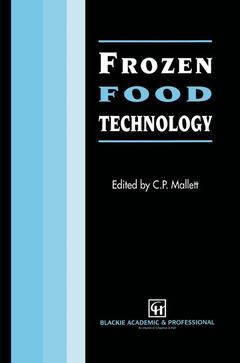Frozen Food Technology, Softcover reprint of the original 1st ed. 1993
Langue : Anglais
Auteur : Mallett C.P.

This book on frozen food, as its title suggests, is written for the food technologist and food scientist in the frozen food industry, which includes both food and equipmentmanufacturers. The information will also be useful for otherdisciplines within the food industry as awhole, and for studentsoffood technology. The book, the aimofwhich is to provide an up-to-date reviewofthe technologyofthe frozen food industry, has been divided into two parts, dealing with generic industry issues and specific product areas, respectively. The first section opens with a chapter on the physics and chemistryoffreezing, including a review ofglassy states. The practical realisationoffreezing is covered in the next chapter, which also covers frozen distribution and storage. Chapter 3 deals with packaging and packaging machinery, a sector where there has recently of product safety is been considerable technological progress. The key area discussed in detail in chapter 4, and includes microbiology and hygienic factory design, as well as consumer reheating, particularly microwave reheating. Health and dietary considerations have become much more important to consumers, and chapter 5 reviews the current nutritional status of frozen foods and their role in a modem diet. The driving force for scientific and technological change in frozen foods is the massive market for its products and the consequent competitive pressures, and the first part ofthe book concludes with a chapter on development ofnew frozen products, and how to apply the technical knowledge, both generic and product specific, to innovate in a consumer-driven market.
1 Basic physical phenomena in the freezing and thawing of plant and animal tissues.- 1.1 Introduction.- 1.2 Physical transformations of freezing.- 1.3 Freezing of plant tissues.- 1.4 Freezing of animal tissues.- 1.5 Freezing of biopolymer solutions.- 1.6 Comparison of freezing and thawing.- 1.7 Computer modelling of the freezing process.- 1.8 Comparison of freezing with alternative preservation technologies.- References.- 2 Freezing technology.- 2.1 Introduction.- 2.2 Definitions.- 2.3 Thermodynamic aspects.- 2.4 Freezer selection.- 2.5 Air-blast freezers.- 2.6 Contact freezers.- 2.7 Cryogenic freezers.- 2.8 Physical storage and distribution of frozen foods.- References.- 3 Packaging of frozen foods.- 3.1 Introduction — why use packaging?.- 3.2 Criteria for material selection.- 3.3 Packaging types.- 3.4 Primary packaging.- 3.5 Secondary packaging.- 3.6 Tertiary packaging.- 3.7 Temperature indicators.- 3.8 Cartoning machines for primary packaging of frozen foods.- 3.9 Vertical farm-fill-seal (FFS).- 3.10 In-line pouch-forming equipment.- 3.11 Packing using horizontal form-fill-seal machinery.- 3.12 Hooders and lidders.- 3.13 Machinery for tertiary packaging.- References.- 4 Product safety from factory to consumer.- 4.1 Quality assurance philosophy.- 4.2 Microbiological aspects of safety.- 4.3 Chemical and physical aspects of safety.- 4.4 Factory design.- 4.5 Final product.- Acknowledgements.- References.- 5 Nutritional aspects of frozen foods.- 5.1 Introduction.- 5.2 Recent developments in nutritional guidelines.- 5.3 Effects of freezing and frozen storage on nutrients in fruits and vegetables.- 5.4 Effects of freezing and frozen storage on nutrients in meat and meat products.- 5.5 Effects of freezing and frozen storage on nutrients in fish.- 5.6 Comparison with othermethods of preparation.- 5.7 Conclusions.- References.- 6 Developing products for the market.- 6.1 Introduction.- 6.2 Marketing aspects.- 6.3 The development process.- 6.4 Research and development.- 6.5 Packaging and product development.- 6.6 Quality aspects.- 6.7 Conclusions.- References.- 7 Meat and meat products.- 7.1 Introduction.- 7.2 Composition and structure of meat.- 7.3 Factors influencing the characteristics of meat.- 7.4 Freezing of meat.- 7.5 Retail cuts.- 7.6 Added-value meat products.- Acknowledgement.- References.- 8 Fish and shellfish.- 8.1 Introduction.- 8.2 Fish species—types, occurrence and importance of frozen preservation.- 8.3 The catching and handling of fish and shellfish for subsequent freezing.- 8.4 Intermediate fish processing.- 8.5 Added-value processing of fish.- 8.6 Shellfish.- 8.7 Surimi technology.- 8.8 Storage effects in frozen fish and shellfish.- References.- 9 Freezing of vegetables and fruits.- 9.1 Introduction.- 9.2 The processing of vegetables.- 9.3 Major vegetables and fruits.- 9.4 Added-value products.- References.- 10 Manufacturing of frozen prepared meals.- 10.1 Introduction.- 10.2 Materials flow for frozen-meal production and assembly.- 10.3 Preparation of components.- 10.4 Assembly of meal components.- References.- 11 Frozen bakery products.- 11.1 Introduction.- 11.2 Fully-baked products.- 11.3 Frozen dough.- References.
Date de parution : 10-2012
Ouvrage de 339 p.
15.5x23.5 cm
Thème de Frozen Food Technology :
Mots-clés :
© 2024 LAVOISIER S.A.S.



